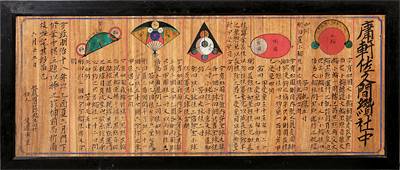At one time, around the late 1600s to early 1800s, Japan had little contact with Europe. In that era Japanese mathematics developed significantly, but in isolation.
During this period a tradition developed of painting geometrical therorems, or sometimes just questions, on wooden tablets, called Sangaku, often in bright colours and with decorative feeling, and depositing them in temples as religious offerings.
As a mathematician of sorts, and in common with many other mathematicians, I find this unique act highly moving.
Only about about 900 have come down to the present.
Sangaku concerned geometric problems; simple shapes such as lines, circles, trianges, squares; in contact; and dimensions. Here is an example which appears on many sites (and so I don't know who to atrribute the image to).

Many of the problems are very difficult, and two were not solved until this century, one only in 2016 and in a long and techical paper. But here's a simple example, in the Sangaku tradition, that you might like to try.

The two big circles have radius 2. What is the radius of the small one? Can you prove it?
PS it's meant to touch the line, my bad drawing!!
Comments
Solution
Introduce some points and lines
We know the radius of the big circles is 2. Let the radius of the small one be r. We have
O2B = 2, so O3A = 2 - r
O3O2 = 2 + r
O2A = 2
Applying Pythagoras
(O3O2)2 = (O2A)2 + (O3A)2
(2 + r)2 = 22 +(2 - r)2
Expanding
4 + 4r + r2= 4 + 4 - 4r + r2
Cancelling
4r = 4 - 4r
Rearranging we get
4r = 4
and so r = ½.